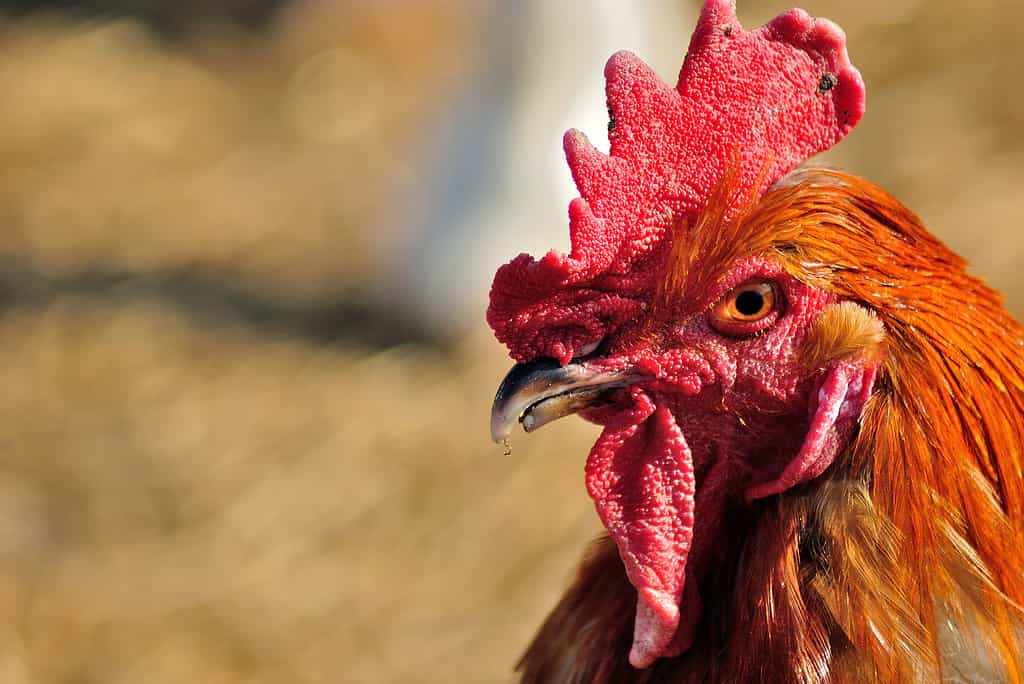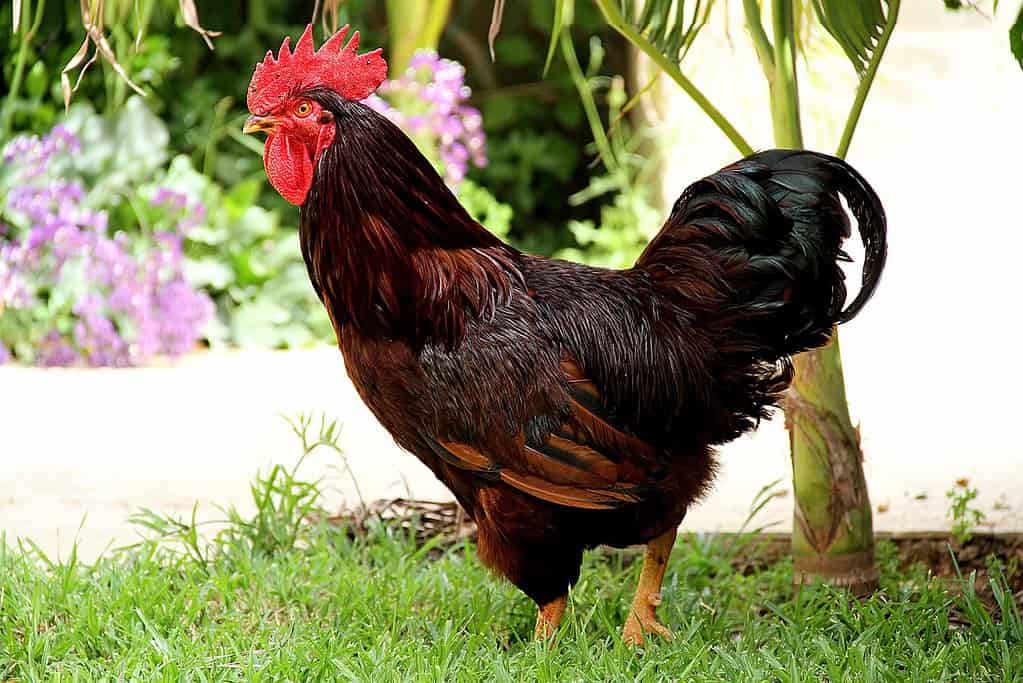The Rhode Island Red chicken is one of the most popular dual-purpose breeds ever created. This large breed, originally developed in Rhode Island and Massachusetts in the mid-1800s, produces between 200 to 300 eggs per year. Hens begin laying as young as six months of age, earlier than many other breeds. Even better, given time to grow to maturity, the birds also provide a substantial amount of tender and delicious meat. So, you may be wondering, how big do Rhode Island Red chickens get? And how long does it take for them to reach their full size? Read on to discover the answers to these questions and more.

Rhode Island Reds take up to five months to reach butchering size.
©Tadulia/iStock via Getty Images
How Big Do Rhode Island Red Chickens Get?
Rhode Island Red chickens average approximately 8.5 pounds for roosters, and up to 6.5 pounds for hens. Of course, some individual birds can attain higher weights. The average size of Rhode Island Red cockerels, or immature roosters, is about 7.5 pounds, and pullets, or immature hens, weigh around 5.5 pounds. This breed ranks among the larger domestic chickens, but not nearly the biggest.
When Do Rhode Island Red Chickens Reach Full Size?
Although Rhode Island Red chickens begin laying eggs earlier than many other breeds, around six months of age, they take a lot longer than typical broiler chickens to reach full size. Chicken breeds raised strictly as broilers and roasters can be harvested as early as eight weeks. By 12 weeks, those breeds can surpass 10 pounds in size. Conversely, Rhode Island Red chickens do not reach butchering size until about five months. They grow slowly, but owners swear that their meat is well worth the wait.
Comparing Rhode Island Red Chickens with Their Predecessors

The Rhode Island Red has a complex ancestry, including the Leghorn and Asian breeds.
©Vitag, CC BY-SA 3.0 <https://creativecommons.org/licenses/by-sa/3.0>, via Wikimedia Commons – License
The Rhode Island Red originated from crosses between brown Leghorn chickens, Asian breeds including the Malay and the Cochin, the American-bred Java chicken, and perhaps others. The resultant Rhode Island Red is a large and hardy breed, but how does its size compare with its predecessors? Let’s take a look.
Leghorn
The Leghorn chicken originated in Italy. Well known as a proficient layer, the Leghorn has proved useful in developing many egg-laying and dual-purpose breeds. Leghorns are smaller than Rhode Island Reds. Roosters average just 6 pounds, while hens reach about 4.5 pounds.
Malay
Malay chickens originated in southeast Asia and are known for their impressive height. Malays can reach heights up to 3 feet. These strong and muscular birds maintain a lanky form. Roosters weigh approximately 9 pounds, and hens average 7 pounds when fully grown.
Cochin
Cochin chickens are anything but lanky. These birds look like huge, rounded, fluffy hearts. Cochin chickens, known for their abundant feathers and robust size, have an especially calm and friendly demeanor. Roosters average around 11 pounds. Hens, meanwhile, weigh as much as Rhode Island Red roosters, tipping the scale at 8.5 pounds.
Java
Java chickens, first bred in the United States prior to the Civil War, came from unknown Asian ancestors. Though it was used to help create one of the most popular chicken breeds in the world, the Rhode Island Red, the Java chicken now teeters on the edge of extinction. Roosters of this breed weigh about 9.5 pounds, while hens average around 7.5 pounds.
Changes in the Rhode Island Red Chicken
Over time, most chicken breeds change as owners select the traits they find most desirable. Some become more elaborate birds, with wild crests, heavily feathered feet, complicated combs, gigantic earlobes, or flowing tail feathers that boggle the imagination. Owners breed for height, weight, color and pattern variations, egg colors, growth rate, and all sorts of other traits, seeking to improve a breed or to create new breeds entirely.
In chickens such as the Rhode Island Red, one of the traits breeders often select for is egg production. In order to improve egg production since about the 1940s, certain other changes have happened to the Rhode Island Red. While the breed started out as a dual-purpose bird, excellent for both meat and eggs, the production lines of Rhode Island Reds have gotten progressively smaller. Hens have become less broody, and the overall color of the birds has lightened. Much the same thing happened with the production line of Leghorn chickens, which are now quite different than the heritage variety.

Heritage-type Rhode Island Red hens are larger and broodier than the production variety.
©Nadanka/iStock via Getty Images
Conservationists hope to preserve the larger, darker, broodier heritage variety of the Rhode Island Red chicken. This older form of the breed may not produce quite as many eggs, but it remains the living link to the dual-purpose chicken that originated long ago.
The photo featured at the top of this post is © Nadanka/iStock via Getty Images
Thank you for reading! Have some feedback for us? Contact the AZ Animals editorial team.







